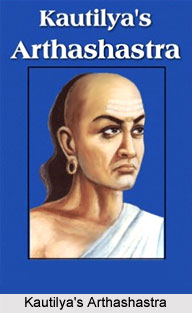 Arthashastra which has been treated as the most authoritative treatise of Hindu polity includes an in depth and scientific study of Statecraft with distinctive diplomatic policies and war strategies. As one of the authentic treatise the book Arthashastra basically means subsistence of mankind in terms of Artha or wealth, which also means earth which contains the mankind; and the science which treats the means of acquiring and maintaining the earth is Arthashastra, the Science of Polity. The book Arthashastra has been further divided into 15 Books, 150 chapters, 180 sections, and 6000 slokas. Each section includes a logical discussion on the needs of the state and its origin; forms of government etc. This had been the initial parameter of Book I. The second Book deals with the duties and frights of various government officers; the third and the fourth section deals with the judiciary and code of conduct ; while the fifth section includes description of the duties and responsibilities of the king`s servants; the sixth section gives a description of the seventh organ of the State called the `Saptanga` theory. The remaining sections are concerned with the `Mandal` theory, external affairs, War and Peace theories, and strategies of diplomacy.
Arthashastra which has been treated as the most authoritative treatise of Hindu polity includes an in depth and scientific study of Statecraft with distinctive diplomatic policies and war strategies. As one of the authentic treatise the book Arthashastra basically means subsistence of mankind in terms of Artha or wealth, which also means earth which contains the mankind; and the science which treats the means of acquiring and maintaining the earth is Arthashastra, the Science of Polity. The book Arthashastra has been further divided into 15 Books, 150 chapters, 180 sections, and 6000 slokas. Each section includes a logical discussion on the needs of the state and its origin; forms of government etc. This had been the initial parameter of Book I. The second Book deals with the duties and frights of various government officers; the third and the fourth section deals with the judiciary and code of conduct ; while the fifth section includes description of the duties and responsibilities of the king`s servants; the sixth section gives a description of the seventh organ of the State called the `Saptanga` theory. The remaining sections are concerned with the `Mandal` theory, external affairs, War and Peace theories, and strategies of diplomacy.
Books of Arthashastra
Arthashastra includes 15 books that deal with several subjects related to state administration. It includes certain unique theories of Saptanga theory in which Kautilya propounded that a state usually exists with the Matsya Nyaya which means the bigger fish shall swallow the smaller fish and only the fittest shall exist. Overall a state includes seven organs which include a Rajan (king), Amatya(minister), Janapada(territory), Fort, Treasury, Army, and Friends. While he discusses them at length which forms the internal administration of the kingdom; another theory known as Mandal theory discusses foreign policy of the king, his relations with other neighbouring rulers, with the enemy, and enemy`s allies and his allies. As such it forms the core of Kautilya`s policy of Diplomacy. Along with this the book gives a detailed description regarding the role of the Envoys and the then Local Government which existed within the Maurya Empire. The local government shall be administered by a parishad of 30 members which introduced the new methods of administration which continues even now.
Mandal theory forms the base of international system which prevailed at the time. Book II to Book XVIII has discussed the relations which the state is supposed to develop with its neighbouring states. The Mandal Theory further includes the diplomacy policy of the kingdom. This includes the relationship which exist within the surrounding states which has been included as the Circle of State, which further discusses the relationship of the conqueror or the Vijigishu who desires in expansion of his territory; Ari or the enemy who surrounds the conquerors state; the madhyama king and the udasin king or the neutral king who are included in the Circle of States. This further includes the policy of diplomacy which includes the role of the Envoys, spies, and messengers or Dootas. Kautilya lays a lot of stress on the role of the envoys who are represent their state in abroad as the present day ambassadors do. Thus, they should be given ministerial status on whom will depend the foreign relations of the conqueror.
Thus Arthashstra is one of the legendary treatises of ancient India which remained incomparable till age.



















